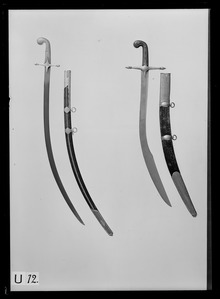
Back سيف أحدب Arabic Cimitarra AST Semterenn Breton Simitarra Catalan Krumsabel Danish Scimitar (Waffe) German Cimitaro Esperanto Cimitarra Spanish Zimitarra Basque شمشیر شرقی Persian

A scimitar (/ˈsɪmɪtər/ or /ˈsɪmɪtɑːr/)[1] is a single-edged sword with a convex curved blade[2][3][4] of about 76.2 to 91.44cm (30 to 36 inches) associated with Middle Eastern, South Asian, or North African cultures. A European term, scimitar does not refer to one specific sword type, but an assortment of different Eastern curved swords inspired by types introduced to the Middle East by Central Asian ghilmans. These swords include the Persian shamshir (the origin of the word scimitar), the Arab saif, the Indian talwar, the North African nimcha, the Turkish kilij, and the Afghan pulwar.[4][5] All such swords are originally derived from earlier curved swords developed in Turkic Central Asia (Turkestan).[6]
- ^ "Scimitar". Merriam-Webster.com Dictionary. Merriam-Webster.
- ^ Gordon, D. H. (1958). "14. Scimitars, Sabres and Falchions". Man. 58: 22–27. doi:10.2307/2795551. ISSN 0025-1496. JSTOR 2795551. Archived from the original on 2021-07-29. Retrieved 2021-07-29.
- ^ Grancsay, Stephen V. (1935). "An Indian Scimitar". The Metropolitan Museum of Art Bulletin. 30 (7): 141–142. doi:10.2307/3254984. ISSN 0026-1521. JSTOR 3254984. Archived from the original on 2021-07-29. Retrieved 2021-07-29.
- ^ a b Föll, Helmut. "Sword Types - Iron, Steel and Swords". Christian-Albrechts-Universität zu Kiel. Faculty of Engineering, Kiel University. Retrieved 2021-08-02.
- ^ Sayadi, Omer (2020-03-16). "The scimitar". MENA symbolism. Archived from the original on 2021-10-19. Retrieved 2021-07-30.
- ^ Nicolle, D. (2007). Crusader Warfare: Muslims, Mongols and the struggle against the Crusades. Hambledon Continuum. p. 175.